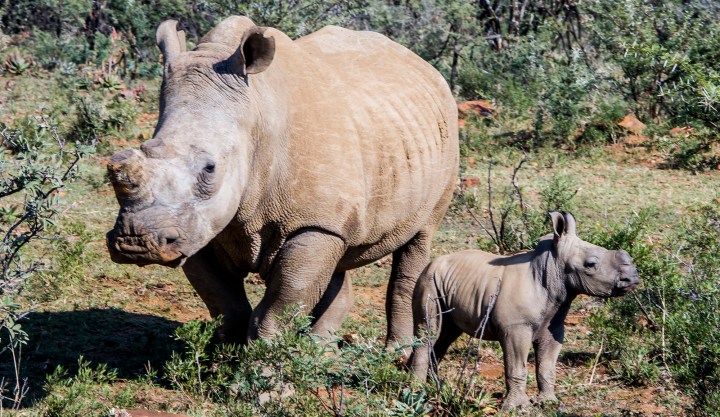SAVING PRIVATE RHINO
Enforcing horn trade ban — the world needs to channel its inner rhino mom

Claims that the global ban on the rhino horn trade cannot work ignore the fact that relevant parties haven’t yet made like a rhino mom and put their whole, unwavering weight behind the prohibition.
When a rhino mom charges to protect her little one from a threat, she puts her all into it. Despite her poor eyesight, she rushes towards the danger with precision, placing her tanklike body between her young and the menace where possible. The no-holds-barred approach to saving her offspring leaves few would-be attackers unscathed.
This level of resolution has been largely lacking in the global (human) community’s efforts to enforce a ban on the trade in rhinos’ horns. As the Environmental Investigation Agency’s (EIA’s) Taylor Tench puts it, “we’ve never been all on the same page” when it comes to adopting measures to make the prohibition work.
Advocates for international trade in rhino horn — ostensibly from dehorned farmed individuals — rarely point this out when arguing that the ban hasn’t worked, as they have claimed following John Hume’s attempted auction of his giant rhino farm. But it is a critical point to understand in the debate over trade because it shows the ban has much room for improvement.
Global ban: reality check
Parties to the global wildlife trading body — the Convention on International Trade in Endangered Species of Wild Fauna and Flora (Cites) — agreed to ban the international trade in rhinos’ horns in 1977.
The prohibition had limitations right from the start, according to Tench, a senior wildlife policy analyst based in EIA’s Washington, DC, office. He points out that some of the major players in the trade were not parties to Cites until long after 1977. Yemen, for example, which was a significant consumer country for many years, only became a party to Cites in 1997.
After the ban’s introduction, thriving domestic markets also continued. This was the case for other key consumer nations like China, which only shut down its domestic trade in 1993. It has more recently relaxed some restrictions.
South Africa, meanwhile, continued a domestic trade in rhinos’ horns until the government introduced a moratorium in 2009. This was lifted in 2017 because of legal action by Hume and another private rhino owner.
Elsewhere, it remains legal to trade pre-1947, worked rhino horn, such as antique items. Moreover, it’s still possible to move such antique products, along with hunting trophies, internationally, meaning the global ban does not wholly prohibit the trading of rhino horn overseas.
Exceptions create pathways for criminals to exploit
Kenyan conservationist Paula Kahumbu has called for a full ban on the rhino horn trade, not least because legal trade provides cover for illicit activities. Indeed, the legal trade has frustrated efforts to tackle rhino horn trafficking, according to retired US Fish and Wildlife Service (FWS) agent Tim Santel, who now works with the nonprofit organisation Focused Conservation.
Santel was the special agent in charge of the FWS Special Investigations Unit at the time of Operation Crash, a yearslong criminal investigation into the US’s role in the trade. He says that the antiques trade posed a particular challenge, with many auction houses selling rhino horn products at the time, the exact origin of which were almost impossible to tell upon sight.
“This is the question that nobody asks,” Santel says, in relation to the push to open international trade.
Although it may be possible to establish the legality of a horn in the earliest stages of a commercial supply chain, such as through DNA testing, microchipping and tagging, once it’s shipped off to be worked into a libation cup or carving at a factory, then sent to an auction house or online marketplace to be sold, how do you know it came from legal stock?
“How can you look at a cup and say that cup is legal, and that cup is not legal? You can’t do it,” Santel says.
The retired FWS agent also argues that exemptions to wildlife trade bans help offenders. Once you start making exceptions, you’re “creating these pathways for the criminals and the wildlife traffickers to exploit”, he says.
Cites was approached for comment but did not respond.
Stockpiles: a trafficker’s dream
Rhino horn stockpiles provide wildlife traffickers with a further pathway for exploitation. According to a 2022 Wildlife Justice Commission report, up to one-third of rhino horn seizures over the past decade may have originated from legal stockpiles. These horns came from the private sector, such as rhino farms, and government stocks, entering the illegal trade through “theft or illegal sale of horns”, the report said.
Before this, a 2012 report by Traffic highlighted that “serious discrepancies” emerged in records of the South African private sector’s stockpiles of rhino horn from 2009, with “unscrupulous” wildlife industry insiders believed to be selling them to criminal actors. This triggered the country’s moratorium on the domestic trade, it said.
Tench says the situation shows that “it’s impossible to control the entire supply of rhino horn”, casting doubt on any argument that if Cites lifted the global ban, the source and supply of horns could be strictly controlled.
To eliminate the risk that stockpiles pose, Kenya laid down a proposal at a Cites conference in 2022. The country called for talks on starting a conservation fund for elephant and rhino range states that they could access upon the non-commercial destruction of their elephant ivory and rhino horn stockpiles.
In its proposal, Kenya explained that stockpiles provide “poachers, traders, speculators, and consumers” with reason to think that trade “may be restored” and therefore “maintains or expands commercial demand”. However, in a further example of a lack of unified, concerted global action, Kenya’s proposal did not garner enough support to move forward.
Legalisation would make demand explode
Despite the trade ban’s limitations, there have been sustained periods of low rhino killing since its introduction. From the 1990s to the mid-2000s, for example, poaching numbers in South Africa specifically remained consistently low.
Tench says that the 1990s were “the closest the world got to true prohibition” of any legal trade, with China and Yemen cracking down domestically. He points to other progress in the years since, such as countries updating and implementing national laws to treat horn trafficking as a serious crime.
From around 2008, however, rhino killing spiralled. The poaching peaked in the mid-2010s but remains very high. Within this period, Vietnam has become a significant player in the trade.
Several factors appear to be involved in the enduring onslaught. These factors include that, for a time, Vietnamese criminals utilised the trade exemptions enjoyed by the trophy-hunting industry and participated in so-called pseudo-hunts to secure horn. The socioeconomic situations in source and destination countries also factor in, as do ever more extravagant rumours about the health benefits of consuming rhinos’ horns.
Wildlife Justice Commission investigations show that the major driver in terms of demand currently is for luxury and status goods, such as carvings. Studies suggest that these people will not be satiated by a legal supply of horn from farmed rhinos, as they covet products from wild animals.
Indeed, legalising international trade risks making it easier for criminals to launder horns from poached individuals and, as Kahumbu warned, could expose “wild rhinos to greater threats from poachers than ever before”.
The EMS Foundation’s Michele Pickover also cautions that a legal trade would expand demand.
“Once you start opening the trade in any animal, it then becomes sought after, and it just grows and grows,” she says.
Pickover adds that once stimulated, trying to contain demand would be near impossible.
Rhinos won’t win in legal trade
For Dung Nguyen of Education for Nature – Vietnam, “The killing of rhinos will only stop when the buying stops.”
Effective enforcement is particularly important to deter buying by those driving demand currently — wealthy, status-hungry consumers, according to Tench.
Enforcement at many levels appears to need improvement, including international institutions like Cites better holding countries to account for trafficking-related high-level corruption.
The initiation of consistent, multiple-country efforts to take down criminal groups is also critical because, as Dung has argued, “We need to be prosecuting the kingpins at the top of the criminal networks to finally shut them down for good.”
The international community needs to provide financial support to rhino range states for enforcement and conservation too, Tench says. Santel points out that funding and enforcement could intertwine, saying, “In a perfect world, we’d be working on this together and when we take down a transnational organisation that had millions of dollars in their coffers, we would take that money and put it into conservation projects.”
This happened during Operation Crash, with some of the funds it seized going towards conservation.
Above all else, Tench says there needs to be “a clear unified message from all relevant parties that rhinos’ horns are not a commodity”. Santel concludes that an international trade would mean that stockpile owners, including criminal groups, make millions, but “the rhinos aren’t going to win”.
To give rhinos the best chance of winning, many argue that the world must go all in on the ban. In other words, it needs to channel its inner rhino mom and charge. DM
This story was produced with support from Internews’ Earth Journalism Network.


















Oh Dear! The author seems to think that it is possible for “the relative parties to put their whole, unwavering weight behind the prohibition (on rhino horn sales)”. I think that money, greed, and indifference to rhinos means this will never happen. Whatever the chances, it is too wobbly a proposition on which to base the future of rhinos.
“The killing of rhinos will only stop when the buying stops.” Perhaps, but if legal horn is supplied by farmers, poaching will be less attractive as a source of horn. However, the main point is that years of trying have totally failed to curb the demand, so how do we meet this unstoppable buying? The only answer is to legalise rhino horn trade.
“Legalisation would make demand explode” This is a totally unsupported statement, and is possibly untrue. If demand does “explode”, farmers would, in time, be able to meet this demand, but only if the trade is legalised.